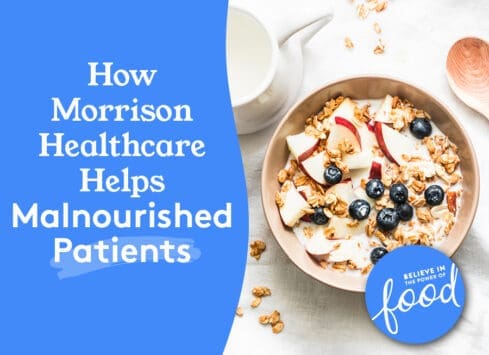How Morrison Healthcare Helps Malnourished Patients
At a hospital in southwest Ohio, Kimberly Ambrose had led the charge for five years to improve patient diagnosis and treatment of malnutrition. Her hard work is now paying off.

In 2021, 713 patients were treated for malnutrition at Marietta Memorial Hospital in Marietta, Ohio, more than double the amount from the previous year. The numbers are continuing to climb in 2022, with 533 patients diagnosed and treated for malnutrition through June. Kimberly, the System Director of Operations, expects them to easily surpass 2021’s count.
While Marietta Memorial is a shining example of how Morrison is making greater strides, it isn’t alone. Data collected by Morrison at the 105 hospitals where it focuses heavily on malnutrition show the company is at the forefront of this trend. Patients treated by Morrison’s experts have a shorter length of stay in the hospital than the national average. And only 13 percent of patients treated at Morrison hospitals for malnutrition are re-admitted, nearly half of the national average of 23 percent.
“We are committed to being the industry leaders in malnutrition diagnosis and treatment, and our leading-edge software is helping us accomplish this goal,” says Maureen Janowski, corporate director of malnutrition programs at Morrison Healthcare. “Our results at Marietta Memorial and at more than 100 other hospitals show we are making a difference.”
How Marietta Memorial Got It Done
Kimberly’s history of working with malnourished patients and her tenacity in educating all of the hospital’s clinical staff is proof that more people are getting help.
She began tackling this issue head-in shortly after arriving in 2017 as a clinical dietitian. Kimberly worked with hospital officials to set up a task force to establish criteria for diagnosing malnutrition. She also updated the nutrition requirements and initial nutrition risk screening protocols for nurses once a new patient arrives.
Over the ensuing years, Kimberly worked closely with the medical staff to ensure nurses began examining newly-admitted patients more thoroughly. Although not mandatory for each nurse to complete the nutrition risk screening on admission, Kimberly set up a competition between nursing units to see which ones would complete the nutrition section more consistently.
“We worked closely with Nursing to encourage and educate them to do an initial malnutrition screening of each patient,” she says. “And that education has paid off. Once those initial screenings are completed, we are now receiving between five and 13 notifications daily for patients at risk of malnutrition.”
Once that notification is received, a dietitian performs a more thorough physical exam called a Nutrition Focused Physical Exam (NFPE). These exams can help identify malnutrition if the patient has weight loss, loss of muscle mass, loss of subcutaneous fat and other issues. If the patient is malnourished, the dietitian can begin the intervention process which can include devising a meal plan that could potentially include providing oral nutritional supplements to increase their calorie intake.
Finally, the dietitian works closely with all medical doctors to ensure they agree with the diagnosis and it is recorded in a patient Electronic Medical Record. Because dietitians and doctors usually see patients at different times, communication between them is paramount.
Technology That Sets Morrison Apart
The other major reason malnutrition cases have increased significantly is the use of My Malnutrition Tools (MMT), a new Morrison proprietary software tool.
The software provides a record of each patient identified as malnourished from the time they are examined by the dietitian until they are discharged. The data helps Morrison’s team identify any missed opportunities. For example, it will show when the dietitian identified malnutrition but the patient wasn’t coded with malnutrition at discharge. Proper Medicare coding helps the hospital receive the appropriate reimbursement for the care provided.
Marietta Memorial was one of the early adopters of the software, which aims to improve patient outcomes while improving processes and revenues.
The software has not only met its goals, but has helped Kimberly be much more productive. Until the MMT software was adopted, Kimberly tracked all malnutrition cases manually. This cumbersome task was not only time-consuming; it didn’t allow her to coordinate the diagnoses of nurses, dietitian and doctors, which potentially limited care for patients in the community. The program resulted in increased nursing’s identification of patients, provided more accurate reporting of cases and increased reimbursement and revenues for the hospital from Medicare patients.
The combination of teamwork among the medical staff and the unique Morrison technology is also helping more patients get better care. Kimberly works closely with the nursing and culinary teams to help each patient recognize the importance of more nutritious meal plans that will ultimately increase positive patient outcomes.
“Caring for a person with malnutrition is hard; You can’t fix it in a couple of days and many find it difficult to change their habits once they return home,” Kimberly says. “But we have a dedicated team that works hard to get each patient on the right path. A well-nourished patient doesn’t get readmitted as often and that’s what we want.”



